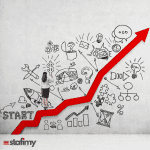
Resilience, as an ambiguous, complex term, within its contested definitions, there is no straight definition of resilience exists in the literature. Many operational definitions indeed echo similar thought as resilience varies based on the definition of adversity and the outcome. Resilience operates at individual, group and organizational levels and mainly incorporates the idea of bouncing-back.
In this respect, commonly used conceptualisations of resilience in the existing literature are as below.
Windle defines resilience as a “… process of effectively negotiating, adapting to, or managing significant sources of stress or trauma. Assets and resources within the individual, their life and environment facilitate this capacity for adaptation and ‘bouncing back’ in the face of adversity.”[1]
Wagnild, and Young explain resilience as “an individual’s emotional endurance and characterizes persons who exhibit courage and adaptability in the wake of crisis and life’s misfortunes.”[2] Rutter’s in her landmark study “Psychosocial resilience and protective mechanisms” defies Resilience as “the individual’s capability to adapt in the face of calamity, strain, suffering, and ongoing consequential life stressors.” [3]Tugade & Fredrickson defines “Resilience may be briefly defined as the capacity to recover or bounce back, as is inherent in its etymological origins, wherein ‘resilience’ derives from the Latin words salire (to leap or jump), and resilire (to spring back).”[4] In their definition Luthar & Cicchetti mentions that “Psychological resilience has been characterized by the ability to bounce back from negative emotional experiences and by flexible adaptation to the changing demands of stressful experiences”[5] Connor & Davidson moves into resilience as a process direction and defines resilience as “a dynamic process wherein individuals display positive adaptation despite experiences of significant adversity or trauma. This term does not represent a personality trait or an attribute of the individual … Rather, it is a two-dimensional construct that implies exposure to adversity and the manifestation of positive adjustment outcomes.”[6] Among all others, another noteworthy definition is elaborated by Luthar S, Cicchetti D, Becker B as “Resilience embodies the personal qualities that enable one to thrive in the face of adversity. … Resilience is a multidimensional characteristic that varies with context, time, age, gender, and cultural origin, as well as within an individual subjected to different life circumstances.” [7]
As seen, there are wide range of views supporting different elements of resilience in the definition with certain commonalties. While a narrower view on resilience mainly gives attention to personality trait of an individual in struggling with unfavorable circumstances, mostly accepted broader view approaches to the resilience as a process which can be improved. In this context, resilience refers to a dynamic process encompassing positive adaptation within the context of significant adversity.[8] Accordingly resilience refers to processes of bouncing back effected by different surrounding elements and resources which can be experimented, learned or thought. Thus while first school of through assumes resilience as set of characteristics including hardiness, coping, self-efficiency, optimism, patience, tolerance, faith, adaptability, self -esteem and sense of humor[9], and those certain characteristics serve as protective factors, second school of thought identifies resilience as a process of frequent disruption (adversity) and positive reintegration (adaptation), learning from experience and the ability to be thought.[10]
In the view of resilience as a process, conceptualization focus on defining the process as an interactive process, ‘dependent on both individual assets as well as contextual (including physical) and relational resources located in the environment’[11], that is happened during the acute stress situations.
Moving forward, key elements of the process explained in the interactive resilience process by Liebenberg L, et al. in a way to illustrate interaction within the process. Therefore, three broad consensual elements of resilience are adopted in their comprehensive literature review as individual assets, relational resources and contextual resources. [12] Accordingly, while individual assets indicate personal capacities in dealing with adversity, relational resources focus on the environmental relationships which are stable and trusting such as family, colleagues and so on. Finally, contextual sources indicate individual access to the several contextual settings like health care, job market and so on. Thus, theory stipulates that interaction of individual capacity with external resources is determinant in assessing managing stressful acute or chronic situations. [13]
Measuring Resilience
In the current literature there are different ranges of scales recognized for the measurement of resilience fordifferent age groups as target group. Among the major ones, for the purpose of this study, only adult targeting scales are focused and compared in below.
| Name | Author(s): | Target population | Length | Concept Measured | |
| 1 | The Dispositional Resilience Scale (1) | Bartone (1989) (1991) (1995;2007) | Adults | 45 Items 30 Items 15 Items | Psychological hardiness (commitment, control, and challenge). |
| 2 | The Connor-Davidson Resilience Scale (CD-RISC) | Connor & Davidson (2003) | Adults (mean age 43.8) | 25 Items | Stress Coping Ability through five factors :
Personal competence, Trust – tolerance – strengthening effects of stress, Positive acceptance of change and secure relationships, Control, Spiritual influences |
| The Connor-Davidson Resilience Scale (CD-RISC) | Cambell-Sills & Stein (2007) | Young adults (mean age =18.8) | 10 Items | ||
| 3 | The Resilience Scale for Adults (RSA) | Friborg et al. (2003) | Adults (mean age women=33.7, men=36.2) | 37 Items | intrapersonal and interpersonal protective factors presumed to facilitate adaptation to psychosocial adversities : personal competence, social competence, family coherence, social support, personal structure. |
| 4 | The Brief Resilience Scale | Smith et al. (2008) | Adults (mean age range 19-62) | 6 Items | Assess the ability to bounce back or recover from stress. |
| 5 | The Resilience Scale (RS) | Wagnild & Young (1993) | Adults (some application with 16-23) | 25 Items | Individual resilience (personal competence and acceptance of self and life); a positive personality characteristic that enhances individual adaptation. |
| 6 | Ego Resiliency | Klohnen (1996) | Adults (18-48) | 20 Items | Assess the components of ego-resiliency: confident optimism, productive and autonomous activity, interpersonal warmth and insight, skilled expressiveness. |
[1] Windle G. What is resilience? A review and concept analysis. Rev Clin Gerontol. 2011;21(2):152-169. doi:10.1017/S0959259810000420.
[2] Wagnild, G., Young, H. M. (1990). Resilience among older women. Journal of Nursing Scholarship, 22(4), 252–255.
[3] Rutter, M. (1987). Psychosocial resilience and protective mechanisms. American Journal of Orthopsychiatry, 57(3), 316.
[4] Davidson, J. R. T., Payne, V. M., Connor, K. M., Foa, E. B., Rothbaum, B. O., Hertzberg, M. A., et al. (2005). Trauma, resilience, and saliostasis: Effects of treatment in post-traumatic stress disorder. International Clinical Psychopharmacology, 20 , 43–48 p. 43
[5] Tugade, M. M., & Fredrickson, B. L. (2004). Resilient individuals use positive emotions to bounce back from negative emotional experiences. Journal of Personality and Social Psychology, 86, 320-333., p. 320).
[6] Luthar, S. S., & Cicchetti, D. (2000). The construct of resilience: Implications for interventions and social policies. Development and Psychopathology, 12, 857- 885. p. 858
[7] Connor, K. M., & Davidson, J. R. T. (2003). Development of a new resilience scale: The Connor-Davidson resilience scale (CD-RISC). Depression and Anxiety, 18, 76-82., p. 76)
[8] Luthar S, Cicchetti D, Becker B. (2000). The construct of resilience: a critical evaluation and guidelines for future work. Child Dev, 71: 543–62
[9] Grafton E, Gillespie B, Henderson S. (2010). Resilience: the power within. Oncol Nurs Forum. 2010 Nov;37(6):698-705. doi: 10.1188/10.ONF.698-705. PMID: 21059582.
[10] Ibid.
[11] Liebenberg L, Joubert N, Foucault M. (2017) Understanding core resilience elements and indicators: a comprehensive review of the literature. Ottawa: Public Health Agency of Canada Liebenberg L, Joubert N, Foucault M. Understanding core resilience elements and indicators: a comprehensive review of the literature. Ottawa: Public Health Agency of Canada; 2017.
[12] Ibid p.5
[13] Ibid p.5







